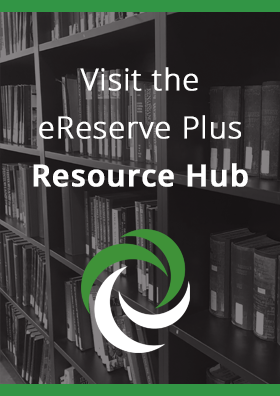At the start of each semester, teachers spend a large amount of time creating and validating reading lists. By simplifying this process and those that surround it, students, librarians and faculty staff can all benefit and put their time to greater use.
eReserve Plus is a reading list tool integrated with your existing library system and used to distribute course materials to students. It makes it easy to locate materials, records what is provided by faculty, ensures copyright compliance when materials are used, and allows students to access updated reading lists from one, central location.
Staff can see which of their reading materials have been accessed by students and how often, while the university has a clearer view of which educational resources are being used. The materials that benefit both students and teachers can be further invested in, and the copyright approval process is simplified and made easier for those on tight schedules or unsure of the requirements.
eReserve Plus allows faculty to see which materials are accessed by students and how often.
Creating effective reading lists at all level of education
As students enter university, many are overwhelmed by the number of texts they feel obligated to purchase and read. As they progress into post-graduate study, the amount of required reading only increases, with some universities even posting guides on how to manage the large workload and depth of reading.
How does eReserve Plus help alleviate some of these issues? For a start, teachers can access eReserve Plus directly from within the Learning Management System to search library catalogue, prioritise and group resources as they create reading lists that students can access from anywhere. Furthermore, as the ability to leave notes is integrated, the most relevant selections from selected readings can be highlighted.
When the reading list creation and approval process is made simpler, it produces a ripple effect that benefits everyone. Librarians are no longer rushed by approving materials for use, teachers are able to access previous readings lists and create their own with ease, and students are provided a central location to access materials from.
 Students can access eReserve from anywhere.
Students can access eReserve from anywhere.Need help creating your next reading list?
Due to the time spent by faculty in compiling reading materials for students – and by librarians in ensuring their copyright compliance – creating a reading list that is both engaging and educational can be a tricky and slow process. What makes a great reading list for students? Below we’ve highlighted just of the reasons eReserve Plus makes their creation a success.
- Texts are available – eReserve Plus ensures key resources are available online – such as ebooks, online articles, scanned sections of material – and improves student access to materials (both physical and digital).
- Students have easy access – With all materials in one location, students can access them as grouped by their teachers in a one-stop digest. Teachers can also link and embed individual items or sets of materials directly within course content in the Learning Management System so they are in context for students to access. This makes navigation of texts and course content much easier.
- Communication is simple – Librarians are no longer forced to chase and follow up reading list submissions to ensure they are completed on time and can review and schedule as they need.
- Guidance – Faculty staff can makes notes on the most relevant items from a suggested list, or highlight required reading to help students prioritise and focus their learning.
- Reading lists are up to date – Keeping your reading list up to date requires little effort and curation. With eReserve Plus, accessing previous reading lists is simple and automated.How eReserve Plus makes the import process easy.
At eReserve, our culture is both inclusive and collaborative. We work with you from the basic set up of eReserve Plus right through to integration, training key staff and support beyond. As eReserve Plus is cloud-hosted, there are no systems to manage or maintain, and nothing that will increase your existing infrastructure requirements.
When identifying existing materials within a university, we can either start fresh or integrate them. Three of the main ways we support in the process are:
- RIS files import (from a variety of library, citation and other systems)
- Flat file ingest (files, meta data and course/subject details all at once)
- Manual addition
We’ve worked with clients who needed to integrate all three, a flexibility that eReserve Plus was able to provide. If you want to learn more about how eReserve Plus can benefit everyone at your academic institution, get in touch with our team today.


